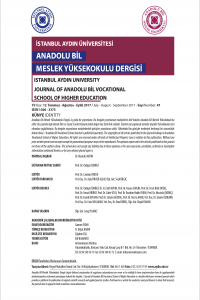İnsani yardım ve lojistik yönetimi
İnsanların ve toplumların başa çıkmakta zorlandığı ya da başa çıkamadıkları, çevreyi olumsuz etkileyen olağanüstü durumlara afet denilmektedir. İnsani yardım lojistiği; acil durum ve afetlerden etkilenmiş ihtiyaç sahiplerine yardım etmek üzere gerekli malzeme, bilgi ve hizmetlerle ilgili lojistik faaliyetlerin etkin ve verimli bir şekilde yönetimidir. Bu çalışmada ilk bölümde; afet yönetimi kavramı üzerinde durulmuştur. Bu kavramla ilişkili insani yardım lojistiği tanımlarına, işlevleri ve süreçlerine yer verilmiştir. Bir sonraki bölümde; etkin insani yardım lojistiği faaliyetleri için işletmelerin sahip olması gereken yeteneklerden ve performans yönetiminden bahsedilmiştir. Sonuç bölümünde ise; insani yardım lojistiği konusunda genel bir derlemeye gidilmiştir
Anahtar Kelimeler:
İnsani Yardım, Lojistik, Performans Yönetimi
Performance management in humanitarian logistics
Extraordinary situations, which people have difficulty in coping up with or fail to cope with and which negatively affect the environment, are called disasters. Humanitarian logistics is the effective and productive management of logistic activities related with the materials, information and services required for helping the people in need who are affected by the emergency and disasters. In the first section of this study; the notion of disaster management is emphasized. Definitions, functions and processes of humanitarian logistics related with this notion are included. In the next section; abilities, which establishments have to possess for effective humanitarian logistics activities, and performance management are mentioned. In conclusion result; a general compilation about humanitarian logistics is provided
Keywords:
Humanitarian, Logistics, Performance Management,
___
- APTE, A. (2009), Humanitarian Logistics A New Field of Research and Action, Foundation and Trends in Technology, Information and Operation Management, Vol.3, N.1, Sy.1-100.
- AYDIN, M. (2009), Afet Sonrasına Yönelik Planlama Çalışmaları: İzmir Örneği, İzmir Kent Sempozyumu, 8-10 Ocak, Sy.115-130.
- COZZOLINO, A. (2012), Humanitarian Logistics, SpringerBriefs in Business.
- DAVIDSON, A.L. (2006), Key Performance Indicators in Humanitarian Logistics, Yükseklisans Tezi, Massachusetts Institute of Technology.
- ERTEM, M.A. BUYURGAN, N. ROSSETTI, M. D. (2010), International Journal of Physical Distribution & Logistics Management, Vol. 40 No. 3, Sy.202-227.
- HOWDEN, M. (2009), How Humanitarian Logistics Information Systems Can Improve Humanitarian Supply Chains: A View from the FieldProceedings of the 6th International ISCRAM Conference – Gothenburg, Sweden, Sy.1-10.
- KOVACS, G. TATHAM, P. LARSON, P.D. (2012), What Skills Are Needed to be a Humanitarian Logistician?, Journal of Business Logistics, 2012, 33(3), Sy. 245–258.
- MCCLINCTON, A. (2009), The Logistics of Humanitarian Emergencies: Notes From the Field, Journal of Contingencies and Crisis Management, Vol.17,N.4, Sy.295-302.
- ÖZMEN, B. NURLU, M. KUTERDEM, K. TEMIZ, A. (2005), Afet Yönetimi ve Afet İşleri Müdürlüğü, Deprem Sempozyumu, 23-25 Mart, Kocaeli.
- PEKTAŞ T. (2012), İlçe Bazında Afet Lojistiği: Başakşehir Uygulaması”, Yükseklisans tezi, BÜ Sosyal Bilimler Enstitüsü, İstanbul.
- TANYAŞ, M. GÜNALAY,Y. AKSOY, L. (2013), İstanbul İli Afet Lojistik Klavuzu, Loder, İstanbul.
- TOMASINI, R.M. WASSENHOVE, L.N.V. (2009), From preparedness to partnerships: case study research on humanitarian logistics, Intl. Trans. in Op. Res. 16, Sy. 549–55.
- T.C. Başbakanlık AFAD Yönetimi Başkanlığı Türkiye Ulusal Afet Arşivi, www.tuaa.afad.gov.tr, (07.09.2013).
- ISSN: 1306-3375
- Başlangıç: 2006
- Yayıncı: İstanbul Aydın Üniversitesi
